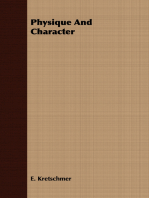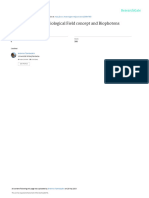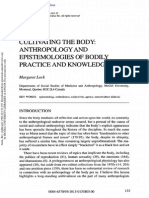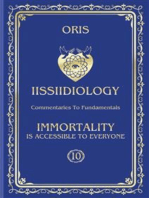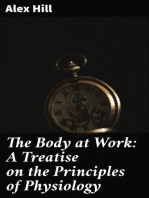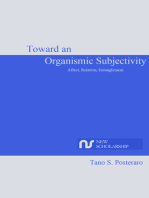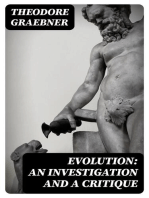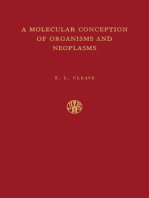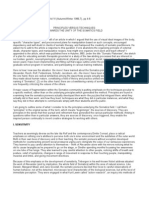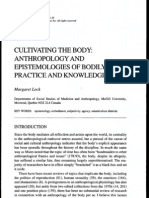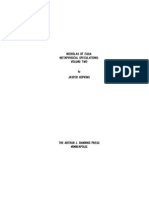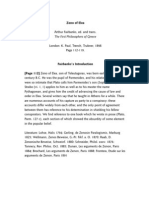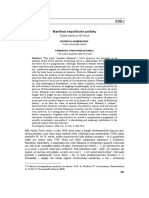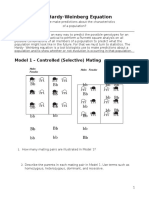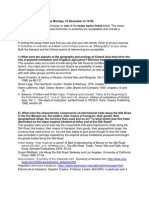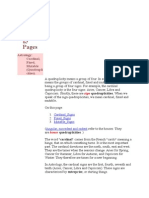Professional Documents
Culture Documents
Methodological vs. Metaphysical Vitalism in Hans Driesch'S Research
Uploaded by
Jorge Nicolás LuceroOriginal Description:
Original Title
Copyright
Available Formats
Share this document
Did you find this document useful?
Is this content inappropriate?
Report this DocumentCopyright:
Available Formats
Methodological vs. Metaphysical Vitalism in Hans Driesch'S Research
Uploaded by
Jorge Nicolás LuceroCopyright:
Available Formats
123
METHODOLOGICAL VS. METAPHYSICAL VITALISM
IN HANS DRIESCH’S RESEARCH
Dariusz A. SZKUTNIK1
ABSTRACT. The aim of the present work is a reconstruction, analysis and
elucidation of Hans Driesch’s vitalistic conception insofar as it was developed in the
course of his biological and philosophical research.
I am presenting two kinds of perspectives, i.e. methodological vitalism and
metaphysical vitalism in Hans Driesch’s interpretation. I am arguing that
methodological vitalism, in contradiction to metaphysical vitalism, is a conditionally
valuable investigative perspective developed in the biological course by Hans
Driesch.
In favor of this thesis, I am analyzing Driesch’s fundamental concepts (e.g.
prospective power, prospective meaning and harmonious-equipotential system), as
necessary means–in his opinion–to be used in effective research and observations in
the domain of morphogenesis, aimed at revealing the developmental specificities of
organic phenomena in contradistinction to inorganic phenomena.
KEYWORDS: entelechy, psychoid, methodological vitalism, metaphysical vitalism,
prospective meaning, prospective power, system harmoniously-equipotential.
Contents
Introduction
1. Experiments
2. System harmoniously-equipotential
3. Psychoid as a category of metaphysical vitalism
4. Driesch on Aristotle; remarks concerning methodological differences
Conclusion
Introduction
I am going to describe and succinctly characterize two types of research-
perspectives developed by the famous German embryologist and philosopher, Hans
Driesch (1867–1941), i.e. the methodological and metaphysical vitalism.
1
Jagiellonian University in Krakow and University of Warsaw, POLAND.
Vol. 4, Nos. 1 & 2,
BIOCOSMOLOGY – NEO-ARISTOTELISM
Winter/Spring 2014
124
As a matter of a fact, Driesch himself did not use terms like “methodological
vitalism” resp. “metaphysical vitalism”. Nevertheless, in his scientific research as
well as in his philosophical deliberations, he was always quite aware of the existence
and essential difference appearing between such two scientific and philosophical
dimensions of his life-work. This was so in spite of the fact that both of these
perspectives were strictly interwoven with each other in his life’s activity.
Since the uniformly developed research-analytical standpoint of Hans Driesch’s
both dimensions of his vitalism, i.e. the methodological and the metaphysical one are
strictly interwoven with each other, it is no wonder that normally these have not been
discerned from each other by historians of philosophy as well as science or by
scientists analyzing Driesch’s scientific achievements.
Yet, it is quite possible to discern and clearly characterize both of these
methodological perspectives developed by him in the course of his biological
research and philosophical elucidations.
Usually, historians of philosophy think that problems and analysis in Driesch’s
research are in modern times are of no scientific or philosophical interest. This may
be taken, however; to be not so much as an outcome of a thorough methodological
and philosophical criticism of his vitalism in all its dimensions, but rather as a
consequence of a heuristic sterility of this standpoint in the course of contemporary
biological research especially in comparison to such a fruitfulness characterizing
disparate reductionistic conceptions of the research approach to living phenomena.
This is just, for example, how Ernst Nagel argues (Nagel 1970, p.369).
However, in my opinion, Driesch’s methodological vitalism possesses positive
value of the inspiring–heuristic character. It has been appearing in the course of
scientific research carried out in embryology in general; it was so, beyond any doubt,
at least in the course of Driesch’s own scientific research. Some important scientific
inspirations have been taken from his conceptual developments; also those
concerning the specifically vitalistic notion of entelechy as a kind of a life-factor – a
term taken over from philosophical tradition going back to Aristotle. Even tentatively
determined, the concept of the entelechy has greatly inspired Driesch’s experimental
research in the domain of the organic morphogenesis; the very primary intuitive
content of this concept inspired Driesch, in his own scientific research, as concerns
his concrete morphogenetic concept-construction, in planning and carrying out his
morphogenetic experiments and observations, as well as in his theoretical
generalizations aimed at showing off the qualitative specificity of living phenomena.
Even a quick look at some of Driesch’s scientific research and achievements
illustrate beyond any doubt the cognitive fruitfulness of his methodological vitalism.
In order to prove this, I am going to describe below, in a very brief way, two of
Driesch’s crucial experiments in embryology which had been the point of departure
for his further biological research and inspired him to further philosophical enquiries
and, finally, even to his later overtly metaphysical speculations.
Vol. 4, Nos. 1 & 2,
BIOCOSMOLOGY – NEO-ARISTOTELISM
Winter/Spring 2014
125
1. Experiments
EXPERIMENT 1
Driesch has been shaking an embryo in the second stage of a cell division and in
some cases he succeeded in killing one of the blastomeres without injuring the second
one or else he succeeded in separating two blastomeres one from the other (Driesch
1908, p.60).
In this kind of experiments, Driesch has been separating one of many cells into
which a zygote has been divided during a process of its ripening. Such a separated
cell, one of four, or of eight, or of sixteen, or of more cells constituting the early form
of an embryo, might then develop quite independently of the rest of the cells, making
up in effect a whole and complete organism. It meant that from the primary one germ,
as constituting a complete whole object, one might obtain many embryos which also
constitute complete structures; this was so quite independently from the fact of into
how many parts the original germ has been divided if only the smallest part of the
original germ had not been smaller than a cell.
After a series of such experiments, carried out in differentiated physical
conditions (attainable, among others, by means of diluting sea water or by increasing
its temperature), Driesch has finally obtained a result which was quite different from
the one obtained by Wilhelm Roux’s research which have been devised from the
point of view of mechanistical perspective.
Wilhelm Roux’s experiments have been carried out in a scientifically correct
way but they were based on theoretically inaccurate, fundamental premises. Roux
believed that a course of a cell differentiation depends completely on its preformed
constituents making up together a kind of spatial mosaic and leads to their duplication
so that any experimental disruption of this fixed order might lead unavoidably to the
destruction of the cell itself. Driesch’s vitalistic approach consisted of rejecting of
this mechanistic view and accepting instead an epigenetic conception of the structure
of a living cell as equipotentially developing system. In effect, his experiments have
been planned to reveal the laws of kind of a structural creativity appearing in primary
stages of the organic development.
EXPERIMENT 2
Driesch has succeeded in pressing rather tightly Echinus’ eggs between two
glass plates without killing them. Then the eggs became deformed to comparatively
flat plates of a large diameter. In those eggs, all nuclear division occurred at the right
angles to the direction of pressure, i.e., in the direction of the plates, as long as the
pressure lasted. But as soon as the pressure has ceased, the divisions began to occur at
right angles to their former direction (Driesch 1908, p.63).
Driesch argued that owing to the fact of a differentiation of pressure exerted on
the embryo during his experiments that he was able to obtain any forms of cell
divisions that he wanted. When he exerted pressure on the eggs until the end of the
eight-cell stadium of the embryo division then he obtained a plate compound of eight
cells placed side by side i.e. one by the other instead of two rings each compound of
Vol. 4, Nos. 1 & 2,
BIOCOSMOLOGY – NEO-ARISTOTELISM
Winter/Spring 2014
126
four cells placed one on the other, just as it used to be in a normal cell division. The
ensuing cell division, however; has been coming in the right-angle direction with
respect to the previous cell division, and an outcome of this process had a form of a
sixteen-cell stadium of the embryo division, compound of two, eight cells plates
placed one on the other. When the pressure has continuously been exerted until the
sixteen-cell stadium of the embryo division was attained then all the sixteen cells
were placed on one plate and side by side one by the other, the result of the further
divisions were two plates, each compound of the sixteen cells placed one on the other
(Driesch 1908, p.63)
According to this briefly presented Driesch’s experiment, one might say that the
normal or undisturbed development of any organism is by no means and in general,
the necessary condition of the completeness of this development. It became quite
clear that the respective spatial relations existing between different divisions of a cell
nucleus are something quite normal. There could not be any closed relation between
single divisions of a cell nucleus and the development of organs in general.
Also, all these experiments have demonstrated that most of the germs may, after
sometime, start to carry out different functions than it has been done before, i.e.
during a normal or undisturbed development. One might even say that despite of all
those experimental manipulations performed on embryos we could see some kind of
a capability and even tendency of living organism towards the holistic development.
Driesch formulated following specific terms of his vitalistically inspired methods of
research in the domain of the embryogenesis: prospektive Bedeutung (a prospective
meaning) and prospektive Potenz (a prospective power). Their meaning might be
briefly explained as follows (let us put it verbatim in Driesch’s own words):
Suppose we have here a definite embryo in a definite state of development,
say a blastula, or a gastrula, or some sort of larva, then we are entitled to
study any special element of any special elementary organ of this germ with
respect to what is actually to develop out of this very element in the future
actual course of this development, whether it be undisturbed or disturbed in
any way; it is, so to say, the actual, the real fate of our element, that we
take in account. I have proposed to call this real fate of each embryonic part
in this very definite line of morphogenesis its prospective value
[prospective Bedeutung in German]. (Driesch 1908, pp.76, 77)
And, at the same time, Driesch has emphasized that in order to be able to do
this, it is necessary to earlier introduce some other concept, i.e. the concept of
“prospective potency” or “prospective power” of every of the embryo’s parts. This
last term should designate a possible fate of every one of those embryo’s parts (once
again verbatim in Driesch’ meaning):
We first introduce a second concept: the term prospective potency
(“prospective Potenz” in German) of each embryonic element. The term
Vol. 4, Nos. 1 & 2,
BIOCOSMOLOGY – NEO-ARISTOTELISM
Winter/Spring 2014
127
“prospective morphogenetic potency” is to signify the possible fate of
each of those elements. (Driesch 1908, p.77)
All developmental possibilities (i.e. potentialities) of a definite part of an
embryo might be carried out by means of respective experimental disturbances of the
course of organic processes under investigation when these disturbances are
conducted in appropriate laboratory conditions. Driesch stated that experiments
concerning the separation of some parts of an embryo demonstrate that the
prospective power of every element of, for example, sea urchin (Seeigel) egg is
constant and that its possible value is variable. That is why the development of any
group of cells of a blastula of the sea urchin would always happen with respect to the
whole organism since it is always oriented in this generally holistic direction by the
appropriate prospective power (prospektive Potenz). And, it is worthwhile to
emphasize that, as it appeared, the main aim of the development might be attained in
many different ways; that is why the further destiny of the sea urchin cells is
characterized as a variable one.
2. System harmoniously-equipotential
In the course of his further research, Driesch has come to a formulation of a
concept of a harmoniously equipotential system whose role was to express an
occurrence of a constant prospective power (prospektiven Potenz).
The living objects of Driesch’s research have been equipotential systems in the
sense that each of their constituents might play a separate function as a part of the
entirety of processes appearing in the whole living system; such a role has been
called a “function of place (location)” or “function of the position”. That is why the
systems in question could be designated as the equipotential systems with separate
powers, or shortly: the individually equipotential systems (Driesch 1908, pp.120,
121).
Driesch attempted to demonstrate that equipotentiality of a system consists
among others in that every of its parts plays some determined role only with respect
to the whole system in question – i.e. with respect to what is going on in the entire
system. Every part of such a system is placed (located) in a way guaranteeing its
determinate contribution to the construction of the system in question as a whole as
well as to its reconstruction (e.g. during a process of regeneration), and it is also able
to perform the same tasks which are playing other parts of the system.
Driesch came to the expressly vitalistic conclusions asking the following
question: under which circumstances might be made conditional the prospective
meaning (prospektive Bedeutung) B in all cases of an experimental influence (e.g.
shaking, separating) on the element X?
Driesch has presented following factors in question (shortly but strictly
according to Driesch’s meaning):
Vol. 4, Nos. 1 & 2,
BIOCOSMOLOGY – NEO-ARISTOTELISM
Winter/Spring 2014
128
First of all, the prospective meaning of every element of the living system
depends undoubtedly on and is a definite function of, the absolute size of
the part of the system in question appearing in it in a given case. Let s
symbolizes the absolute size of a system in any case of a process of
morphogenesis. Then we can state symbolically the appropriate function a
prospective meaning of an element of the living system: B (X) = f (s…). As
it appears, we should assign additionally other quantities to the symbol S,
however. (Driesch 1908, p.114)
One might say that the prospective meaning of an element of a germ depends on
the absolute (total) size of a system, insofar as it is taken in its state just before its
morphogenetic change. Constituents of the system have substance (as if to “know”, in
a way, of how much), which is shaping organs or tissues, and which should be
produced in order to guarantee the complete outcome of the organic development.
Referring to Driesch’s meaning: from the analytical point of view, one can say
that the destiny of every constituent of the developing germ is changing in
dependence on the actual place of real border-lines between parts a¹, b¹ or a², b², with
respect to the fundamental direction-lines or sides of a rectangle a, b under
investigation. Let us designate this location by means of the symbol l as meaning that
a distance of one actual border-line of the given organic part as determined with
relation a to b. Then we could introduce the following, more developed formula of
the function in question: B (X) = f (s, l…), (Driesch 1908, p.124).
The point is that constituents of a germ should be located in any living organism
with respect to appropriate constant points of the system. That is why they can come
into being, in effect, the definite organic form, since the peripheral cells are behaving
in a different way in comparison to those appearing in the center of the system
(Weber 1999, pp.265–295).
Then, one of the most important of Driesch’s conclusions has been developed
(while accentuating its essential methodological meaning) in the following way: the
prospective power of the system in question, or rather of every of its constituents, is
the sum of that what may be carried out in the system by every of these constituents.
Yet, the fact that in every possible case there happens a typical proportional
development is the actual proof that this sum is not only the simple one but it is
presenting a kind of an order. We may call this order a “dependence of location in the
absolutely normal case”. But since we ought to remember that a “prospective power”
or, as it can be otherwise expressed, a relative proportion which is determining
foundations of the harmonious character of the living system, always should co-
determinate this state of affairs, then we may be authorized to apply this expression
without any ado or explanations to the designation of some constant factor on which
there depends the prospective meaning of every element and constituent of the living
system. If we designate the order embracing the prospective power of an organism by
a parameter-symbol E, then we might be able to complete finally the above stated
symbolic expression to the form: B (X) = f (s, l, E) [Driesch 1908, p.124].
Vol. 4, Nos. 1 & 2,
BIOCOSMOLOGY – NEO-ARISTOTELISM
Winter/Spring 2014
129
At this very point of his scientific-experimental research and conceptual-
theoretical analysis, Driesch came to a conclusion that apart from some important but
variable factors such as size or location of constituents of a living system, there is the
invariable value E which could embrace the future potency of this system although it
would not be identical with it. Driesch observed that in principle, in every
experimental case as well as in the normal development of the living organism there
is a factor determining its form which factor becomes always the same. Driesch’s
experimental observations, concentrated exemplarily around cutting across in any
way of the sea urchin (Seeigel) germ, have demonstrated that every part of the germ
is able to develop into a smaller nevertheless functionally complete living organism.
According to Driesch, the factor E was to be a kind of a quasi-physical
parameter peculiar to living world and responsible for the localization of an organic
differentiation. One can add that this factor was to play the main role in the actual,
primary and fundamental conditioning of foundations proper of the very existence of
any creatures of living world.
It is necessary to emphasize that in Driesch’s opinion, entelechy has not been the
source of any form of energy with respect to the parts of matter appearing in
structures of a living world but it were to act on them by means of some or other form
of a limitation or suspension of the range of their possible reactions.
Now, let us briefly assess some of the effects of Driesch’s scientific and
philosophical endeavors. Firstly, we will assess the negative ones.
Looking at it scientifically and in general, Driesch’s theoretical efforts to
effectively establish entelechy as the essential and specific parameter of a living
world have appeared to be completely in vain.
Of course, Driesch’s secondary methodological aim which consisted in his
attempts at constituting biology as one of the elementary sciences of nature, even on
par with physics also appeared to be futile. Biology, projected as the elementary
science of nature, was to have its own fundamental laws of nature as based on its own
primary parameter of natural objects appearing in all living phenomena. As a matter
of fact, this is not or rather could not be the case.
There seems to be, however; many positive aspects to all of Driesch’s
undertakings.
It is still interesting to carefully analyze his efforts in the theoretical-
interpretative dimension of experimental research. It is particularly so where it
concerns the question of some postulated relations of the entelechy as the alleged
specific parameter of life with actual physical parameters characterizing the natural
world. This problem deserves further investigation.
It has become quite clear that Driesch just provably demonstrated in his
experimentally based considerations how much – in many cases, even just completely
– insufficient is any mechanistical view of the living world, just as concerns
compound organic processes. This has promoted a kind of anti-reductionistic
philosophical approach with reference to the dominating mechanicism in biology and
Vol. 4, Nos. 1 & 2,
BIOCOSMOLOGY – NEO-ARISTOTELISM
Winter/Spring 2014
130
what is to be seen quite easily in the course of Driesch’s analysis presented in his
research-dimensions.
It is worthwhile to note that almost all of the elements of research terminology
consisting of dimensions of Driesch’s methodological vitalism appear to be, in
principle, useful and actual still today (Ostrowski 1983, p.82).
For example, conceptual constructs concerning problems connected with
organic totipotentiality, on the ground of which Driesch has been developing his main
morphogenetical research and analysis, is still the essential source of key concepts of
the biology of organic development (Lenartowicz 1992).
While being quite unaware of the fact, we may even dare to say that Driesch
developed a kind of research which presently concerns living phenomena
characteristic for cloning of animal organisms. Driesch’s experimental divisions of
germs which were compound of two or four cells, in order to create identical twins or
quadruplets of sea urchin have been perhaps the first successfully carried out attempts
at an, supported by man, animal cloning which started with a single cell (Wilmut et
all. 2002, p. 90).
Why, then, Driesch’s life activity is usually assessed in the decidedly negative
sense?
I think that it is a matter of incorrect “optics” of looking at the effects of
Driesch’s endeavors.
When looking attentively at the real stages of the development of Driesch’s
research and considerations, we may just see what follows.
While determined by his heuristically fruitful experimental research but unable
to state the factor E as a scientifically grounded parameter of the living nature,
Driesch has started little by little to go beyond science into metaphysical areas by
attributing to the E category extra spatial properties.
At first, entelechy was to be a kind of an intensive diversity (intensive
Mannigfaltgkeit) of spatial and temporal – so that visible – diversity of structural
properties which have been appearing in the course of the processes of organic
development like embryogenesis. It is worthwhile to emphasize that Driesch before
attributing to entelechy the extra spatial properties from his later completely
developed metaphysical vitalism, has tried to find the factor-parameter E exclusively
in the domain of natural structures of living organisms and so proceeding only on the
level of his methodological vitalism.
On the other side, entelechy, as understood on the level of Driesch’s
metaphysical vitalism, was to “act” respectively in the space, but it was at once to
“exist” somehow outside the space so that it could not be located in any spatial point
occupied by living organisms. It was to act in the particular parts of the organism not
undergoing, however; any division into particular parts.
According to this last concept, entelechy was to be deprived of any quantitative
properties. This meant that its inner diversity could not be understood in a way
according to which its parts might occur in different points of space and time in the
living world. In this way, Driesch wanted to explain the fact that spatial divisions
Vol. 4, Nos. 1 & 2,
BIOCOSMOLOGY – NEO-ARISTOTELISM
Winter/Spring 2014
131
carried out, for example, on the body of a germ were not able to impede the
capability of entelechy to drive the harmonious development of a germ.
3. Psychoid as a category of metaphysical vitalism
This essentially substantialist interpretation of the category of entelechy, as
developed by Driesch mainly in the course of deliberations based on his metaphysical
vitalism, was concerned not only with the processes of embryogenesis but
additionally the psychoid, a kind of a quasi-conscious entelechy, and so they were to
have an influence on organic movements of animals including a man.
As a matter of fact, at this very stage of his philosophical speculations, Driesch
has clearly, decidedly and effectively started to substantialize the concept of
entelechy itself in a metaphysical way, and exactly in the strictly psychological sense.
Although, on the other side, no one could fully know why he was afraid of using such
terms like “psychical” or “psychological” with respect to research of organic
movements connected with experiences of the highly organized animals.
Let us briefly indicate the main direction of Driesch’s analytical interests with
respect to the other extra-morphogenetic types of organic phenomena in the
dimension of his metaphysical vitalism.
The further tasks in research undertaken by the embryologist were those in the
area of a physiology of organic movements aimed at developing foundations of his
further philosophical deliberations; and not only those of the strictly scientific and
methodological type but also, and in addition, those undertaken for purely speculative
and metaphysical reasons (Driesch 1908, p.289). Driesch’s research in this domain
concerned organic movements treated as reactions on external stimuli (Driesch 1908,
p.290).
The commonly accepted physiology of that time has been concerned exclusively
with a cooperation of parts of organisms. In Driesch’s opinion, this was not enough;
he tried to find some additional criterion for explaining specific aspects of organic
movements since he believed that any reduction of such a compound processes to
some simple summative system is completely unsatisfactory (Driesch 1908, p.290).
The embryologist emphasized how important is the holistic presentation of the
phenomena of organic movement (Driesch 1908, p.291). One should add that Driesch
at this point in his research still has been occupied with regulative processes although
in a somewhat different sense and aspect in comparison to the one earlier accepted in
the course of his research in the domain of organic morphogenesis.
Driesch has come to a conclusion that there should be “something” that is able
to create respective combinations of muscle movements based on compound analysis
of behavior. That is why Driesch called this unmechanistic factor (until then denoted
conventionally only as a “something”) by means of the term “psychoid”. Psychoid
was to be something analogous to his earlier concept of entelechy in this respect in
which entelechy was to shape, to some extent, only the organic form of a given body;
and psychoid was to be responsible for “behavior” of that body. In Driesch’s deepest
conviction, psychoid, like entelechy, was also to possess the holistic-not-machine-
Vol. 4, Nos. 1 & 2,
BIOCOSMOLOGY – NEO-ARISTOTELISM
Winter/Spring 2014
132
like character but this time it was to be already only the purely immaterial factor.
Psychoid was to use some determined parts of a brain in a way similar to that in
which a pianist uses respective instrument. In this sense, this is why Driesch has
decidedly rejected any possibility of attributing specific functions to the brain itself.
Indeed, one might say that, according to this conception of the philosopher-
researcher, entelechy as well as the psychoid were to be fitted with capabilities of
creating something organic on the grounds of inorganic means. This was so since in
both cases, there appears the fundamental question concerning the integrating factor
which was to be responsible, on one side for compound character of organic
processes and the holistically oriented development of morphogenesis and on the
other side for the behavior of living organism, i.e. mainly for the compound
combinations of organic movements.
In fact, however; Driesch’s concept-construction, while coming to the term
“psychoid”, constituted the essential dividing line between, on one side, his early strictly
scientific using of vitalistic inspirations, e.g. those stemming from Aristotle’s philosophy,
for the planning and respective developing of his biological research; and, on the other
side, the very beginning of his purely philosophical speculations of a strictly
metaphysical character.
The quasi-scientific category of psychoid, in meaning introduced by Driesch, was a
kind of an attempt at further search for the specific life-parameter but this time on a
strictly metaphysical ground.
Of course, there is no doubt that Driesch’s deliberations in the dimension of his
metaphysical vitalism presented completely dubious, and even futile, proposal from the
point of view of the contemporary science and in particular from the point of view of the
methodology of science.
Since I have just treated Driesch’s metaphysics in quite a general way so that at the
end, I shall only indicate which problem-aspects he has developed in his metaphysical
vitalism in his further post-scientific parts of his endeavors, what has found its expression
among others in his fundamental work Philosophie des Organischen: Entelechy and
substance; Biology and Psychology; Problems of Individuals; Metaphysical Perspectives;
Problem of Freedom; Psychology and Parapsychology.
4. Driesch on Aristotle; remarks concerning methodological differences
Although first basing his philosophy upon Plato’s views, Aristotle finally freed
himself from his influence especially with respect to the natural philosophy in its
narrower sense. And he owned this accomplishment to his greater logical precision in
analysing philosophical problems in general. Furthermore, his concept of entelechy
was a combination between idea and reality which is lacking in Plato’s philosophy. In
this sense, Driesch e.g. claimed that this creation was just what the theoretical
investigation of nature required (Driesch 1914, p.21).
Aristotle appears to be the main precursor of all vitalistic theories until the most
recent times.
Vol. 4, Nos. 1 & 2,
BIOCOSMOLOGY – NEO-ARISTOTELISM
Winter/Spring 2014
133
On the other hand, Aristotle’s theory of life is a pure vitalism. Driesch called his
theory a “primitive or naive Vitalism” for it arose from an entirely impartial
contemplation of life’s phenomena and not as the result of struggle against other
doctrines (Driesch 1914, p.19).
Driesch emphasised that Aristotle knew quite well, stemming out of various
observations, that not all embryonic parts are at once simultaneously present in the
developed organism but come successively into being; and thus to use a modern term,
we may call his theory an epigenetic one.
Words like “entelechy” and “dynamics” have been understood by both
philosophers in a different way. By dynamics1, Aristotle did not mean what in
modern terminology, e.g. that of Driesch, would be called potentiality or
totipotentiality2 like totipotent steam cells.
Therefore, entelechy, in Aristotle’s sense, is simply what “exists” in the highest
sense of the word even if it was not strictly a realized thing. Thus the statue taken in
this sense and before it is created, it exists in the mind of the sculptor.
Driesch, concerning Aristotle’s standpoint, claimed that we can see that the
concept of entelechy rather than that of dynamics corresponds, though not
completely, to the modern concept of the potential (Driesch 1914, p.14).
On the other hand, Aristotle has not been conscious of how important is a
relation of specified parts with respect to the whole organism.
In Driesch’s opinion, there appears manifest difficulty in the fact that, as we
have seen, one part of the growing body does not, according to Aristotle, condition
the formation of another part, for this actually implies, to put it briefly, that the cause
of the differentiation of the parts does not lie in the seed; conversely, the seed is to be
regarded as a true part of the growing body (Driesch 1914, p. 14, 15).
Aristotle believed that in the case of morphogenesis there is something which
forms the parts though neither directly as an identifiable entity nor yet as if the final
development was already existent in it.
Morphogenesis, when taken in this sense, i.e. as a whole process, was rather
regarded as a kind of artistic creation.
Therefore, the manner in which each part could arise should have been deduced
on the grounds of the principle that everything which comes into existence, whether
in nature or in art, arises by something actually existent, out of something of a similar
nature and potentially existent. Now, the seed is such an object that, on the grounds
of an impulse and principle, when the impulse ceases, each part comes into being and
comes endowed with soul (Driesch 1914, p.15).
In this way the soul as an actuality, i.e. an entelechy which organizes the body.
Aristotle calls the soul the principle of all living things.
Briefly, one can say that this is the main outline of the Aristotelian theory of
development.
Driesch does not agree with Aristotle’s claim that the question whether soul and
1
E.g., Dynamics of the statue is already contained in the block of marble.
2
Driesch himself does not use the term like this.
Vol. 4, Nos. 1 & 2,
BIOCOSMOLOGY – NEO-ARISTOTELISM
Winter/Spring 2014
134
body are something one has as little sense as it is in the case of wax and its form. The
soul cannot exist without a body, yet it is just not the body itself but rather something
inherent in the body; if the eye were a living being, then eyesight would be its soul,
this last being then the substance as notion or form of the eye; and the eye would be
the matter of the eyesight (Driesch 1914, p.18).
Aristotle cannot start with a more subtle and logical discussion concerning the
conceptions either in dynamics, entelechy and energy (Driesch 1908, pp.153–237) or
of form of matter and substance (Driesch 1908, pp.238–264), and this is how Driesch
did it.
Aristotle was, in Driesch’s opinion, the great father of systematic philosophy,
and should be regarded as the founder of theoretical biology. Moreover, he appears
to be the first vitalist in history since his theoretical biology is throughout vitalistic;
and it should be regarded as a very conscious vitalism indeed for it grew up in
permanent opposition to the dogmatic mechanism maintained by the school of
Democritus (Driesch 1908, pp.143, 144).
However, Driesch has understood the category of entelechy quite differently in
comparison to Aristotle’s concept. It is true that he has borrowed his terminology
from Aristotle, and let that factor in life-phenomena, which he has shown to be a
factor of the true autonomy of life in relation to inorganic world, to be called
Entelechy, though, without identifying his own doctrine with what Aristotle himself
meant by using the word “entelechy”. Driesch has decided to use this word only as a
sign of admiration for Aristotle’s great genius; this word was to be a mould which
Driesch filled with new contents1 (Driesch 1908, p.144).
In general, it seems to me that, in the case of a comparison of Aristotle’s and
Driesch’s standpoints, we are dealing with a generally similar research method which
was developed in a different way. I am inclined to claim that on one side, Aristotle
has only been looking to explain the causes of organic world as based mainly on the
observation of the singular organic phenomena. I think that Driesch based his
vitalistic method mainly on the observation aimed at building a theoretical scheme in
form of a concrete conceptual construction which was then to provide his scientific
analysis.
1
Entelechy is lacking all the characteristics of quantity. Entelechy is order of relation and
absolutely nothing else; all the quantities concerned in its manifestation in every case were to be
due only to means which are used by entelechy itself, or to material conditions which cannot be
avoided.
Entelechy, though not capable of enlarging the amount of the diversity of composition of a
given system, is capable of augmenting its diversity of distribution in a regulatory manner, and it
does so by transforming a system of equally distributed potentialities into a system of actualities
which are unequally distributed.
Entelechy is not energy, not forces, not intensities but entelechy. Entelechy is a factor in
nature which acts teleologically. It is an intensive manifoldness, and on account of its inherent
diversities it is able to augment the amount of diversity in the inorganic world as far as distribution
is concerned. It acts by suspending and setting free reactions based upon potential differences
regulative (e.g. enzymatic catalysis). There is nothing like it in inorganic nature. (Driesch 1908).
Vol. 4, Nos. 1 & 2,
BIOCOSMOLOGY – NEO-ARISTOTELISM
Winter/Spring 2014
135
Conclusion
The article may stir a number of important questions which when taken in general
might be concerned with the meaning of Hans Driesch’s research and its most
important results for the contemporary biology in some of its main branches. Those
problems might concern Driesch’s relevance for today as expressed in terms of
philosophy of science, embryology, morphogenesis, technology (e.g., cloning), etc.
However, were such problems discussed in the article itself, it could break the
thematic unity and, above all, enormously increase the very scope of this work.
Briefly, let us take into account examples of such far reaching problems appearing
out of Driesch’s scientific research and conceptual analysis.
In regards to constituents of a system knowing how much substance to produce
for tissues and organs, it might of course, be tied heuristically with the current
thinking on tissue hormone levels that guide tissue development. But how would it be
possible to even briefly present the main concepts of current thinking on tissue
hormone levels?
Since Driesch has started little by little to go beyond science and into
metaphysical areas by attributing extra-spatial properties to the E category, it might
be considered to link this idea with the concept of Einstein’s cosmological constant;
but this latter concept has also had its own “ups and “downs, so would it be
worthwhile to enlarge such an uncertainty by joining to it a finally ineffective
biological idea?
Whether Driesch’s concept of entelechy acting in space but existing outside of it
might be considered as a sufficient ground for suggesting that he is a forerunner of
the notion of “genes” which exist in each cell and remain intact despite regional
changes? This analogy is just too risky in my opinion and it could hardly be
substantiated in a sufficient way.
It might seem that Driesch’s substantialist interpretation of entelechy could be
contrasted in an interesting way with Bergson’s energetic interpretation but
Bergson’s view never really caught on the strictly scientific level. So that what would
Driesch’s achievements be contrasted with, and how?
Driesch’s concept of “organic movements” has been developed in too a general
way; as a matter of fact, it embraces in many respects almost any specific organic
change so that relating even simple examples of such phenomena could lead
inevitably to many additional explanations.
According to Driesch’s picturesque phrase, psychoid was to “use” some
determined parts of the brain in a way similar to that in which “a pianist uses
respective instrument”. But how could it be stated and understood in strictly scientific
terms? This has never been explained by Driesch himself.
Summarizing – the aim of my present remarks consist of general sketching out of
the key constituents of Driesch’s methodological vitalism as a overall program: how
to construct appropriate conceptual means for guiding strictly scientific research and
even the experimental one with respect to the specific living phenomena and to carry
out this research in a form leading to the discovery of the specific laws of the organic
Vol. 4, Nos. 1 & 2,
BIOCOSMOLOGY – NEO-ARISTOTELISM
Winter/Spring 2014
136
world, and philosophical, even metaphysical, ideas as a potential material for
“coining” such specifically biological conceptual means should not be excluded.
In conclusion, we might say that Driesch’s research in the domain of biology as
well as his philosophical deliberations connect tightly to his fruitful scientific activity
and were very often mistakenly assessed as only pure metaphysics. Driesch’s initial
endeavors have had above all a very deep and autonomous inquiring and scientific
dimension. This is what I was trying to convey in the earlier part of the present paper
on Driesch’s methodological vitalism.
The main reasons for the above described and essentially erroneous
understanding of Driesch’s unquestionable scientific achievements as exclusively
metaphysical speculations seems to stem from two fragmentary analyses of the main
stages of his proper research-work.
As a matter of fact, those are only later speculative-metaphysical aspects of
Driesch’s purely philosophical deliberations which nowadays are usually, and
sometimes even excessively, taken into account and Driesch’s much earlier thorough
although only fragmentary scientific research constituting of heuristically-
methodological and epistemological stage of practicing his heuristic vitalism, either is
not distinguished at all or at most it is essentially diminished as having no real
scientific meaning or value.
It is no wonder that such a drastic narrowing of the perspective of analysis of
Driesch’s vitalistic standpoint might in consequence bring on the exaggerated
emphasizing of his metaphysical vitalism at the expense of his almost completely
overlooked methodological vitalism.
References
Aristotle., De Genertione Animalium. Translated by W.D. Ross. Retrieved
15.05.2014, URL: https://archive.org/details/worksofaristotle512aris
Driesch H., Analytische Theorie der organischen Entwicklung, Leipzig 1894.
Driesch H., Der Vitalismus als Geschichte und als Lehre, Leipzig 1905.
Driesch H., Die Biologie als selbständige Grundwissenschaft, Leipzig 1893.
Driesch H., Die Lokalisation morphogenetischer Vorgänge. Ein Beweis vitalistischen
Geschehens, Leipzig 1899.
Driesch H., Die mathematisch-mechanische Betrachtung morphologischer Probleme
der Biologie. Eine kritische Studie, Jena 1891.
Driesch H., Die organischen Regulationen. Vorbereitungen zu einer Theorie des
Lebens, Leipzig 1900.
Driesch H., The Science and Philosophy of the Organism, London, 1908.
Lenartowicz P., Elementy filozofii zjawiska biologicznego (Elements of Philosophy of
Biological Phenomenon), Kraków 1984.
Lenartowicz, Totipotencjalność kluczowe pojęcie biologii rozwoju (Totipontiality, the
Key Concept of Biology of Development), Kraków 1992.
Vol. 4, Nos. 1 & 2,
BIOCOSMOLOGY – NEO-ARISTOTELISM
Winter/Spring 2014
137
Mocek R., Wilhelm Roux – Hans Driesch. Zur Geschichte der
Entwicklungsphysiologie der Tiere, Jena 1974.
Mocek R., Die werdende Form. Eine Geschichte der Kausalen Morphologie,
Marburg an der Lahn 1998.
Nagel E., Struktura Nauki (The Structure of Science), Warszawa 1970.
Ostrowski K., Embriologia człowieka (Embriology of Man), Warszawa 1983.
Wilmut I., Campbell K., Tudge C., Ponowny akt stworzenia (New Act of Creation),
Poznań 2002.
Vol. 4, Nos. 1 & 2,
BIOCOSMOLOGY – NEO-ARISTOTELISM
Winter/Spring 2014
You might also like
- The Song of the Cell: An Exploration of Medicine and the New HumanFrom EverandThe Song of the Cell: An Exploration of Medicine and the New HumanRating: 4 out of 5 stars4/5 (78)
- Irritability: A Physiological Analysis of the General Effect of Stimuli in Living SubstanceFrom EverandIrritability: A Physiological Analysis of the General Effect of Stimuli in Living SubstanceNo ratings yet
- The New Biology: A Battle between Mechanism and OrganicismFrom EverandThe New Biology: A Battle between Mechanism and OrganicismNo ratings yet
- Volume 11. Immortality is accessible to everyone. «Energy and biological mechanisms of refocusings of Self-Consciousness»From EverandVolume 11. Immortality is accessible to everyone. «Energy and biological mechanisms of refocusings of Self-Consciousness»No ratings yet
- The New Science of Consciousness Survival and the Metaparadigm Shift to a Conscious UniverseFrom EverandThe New Science of Consciousness Survival and the Metaparadigm Shift to a Conscious UniverseNo ratings yet
- Progress in Theoretical Biology: Volume 1From EverandProgress in Theoretical Biology: Volume 1Fred M. SnellNo ratings yet
- The First Cell: The Mystery Surrounding the Beginning of LifeFrom EverandThe First Cell: The Mystery Surrounding the Beginning of LifeNo ratings yet
- Cell TheoryDocument4 pagesCell TheoryDibyakNo ratings yet
- (Ebook) Wilhelm Reich - The Bions (1938)Document44 pages(Ebook) Wilhelm Reich - The Bions (1938)phobossbk100% (2)
- The Evolution of The Biological Field Concept and BiophotonsDocument25 pagesThe Evolution of The Biological Field Concept and BiophotonspatrickmdirksNo ratings yet
- Helmuth Plessner and The Presuppositions of Philosophical NaturalismDocument8 pagesHelmuth Plessner and The Presuppositions of Philosophical NaturalismJan GulmansNo ratings yet
- Darwinian Reductionism: Or, How to Stop Worrying and Love Molecular BiologyFrom EverandDarwinian Reductionism: Or, How to Stop Worrying and Love Molecular BiologyRating: 4 out of 5 stars4/5 (4)
- Harmonizer: Embryology, Developmental Biology, Evo-DevoDocument12 pagesHarmonizer: Embryology, Developmental Biology, Evo-DevoAmala Krishna Das100% (1)
- Anthropology of The BodyDocument25 pagesAnthropology of The BodyНаталья Панкина100% (1)
- Cell TheoryDocument2 pagesCell TheoryJil Lea Viray ManuelNo ratings yet
- Volume 10. Immortality is accessible to everyone. «Fundamental Principles of Immortality»From EverandVolume 10. Immortality is accessible to everyone. «Fundamental Principles of Immortality»No ratings yet
- Reading Schopenhauer in light of modern scienceDocument11 pagesReading Schopenhauer in light of modern scienceAnderson BernardiNo ratings yet
- Etymology: Biology Is TheDocument7 pagesEtymology: Biology Is ThebonnmengulloNo ratings yet
- Steps to Follow: The Comprehensive Treatment of Patients with HemiplegiaFrom EverandSteps to Follow: The Comprehensive Treatment of Patients with HemiplegiaRating: 5 out of 5 stars5/5 (1)
- An Astrological Study Of Psychological ComplexesFrom EverandAn Astrological Study Of Psychological ComplexesRating: 4 out of 5 stars4/5 (12)
- The Law of Psychic Phenomena: Systematic Study of Hypnotism, Spiritism, Mental Therapeutics, Etc.From EverandThe Law of Psychic Phenomena: Systematic Study of Hypnotism, Spiritism, Mental Therapeutics, Etc.Rating: 5 out of 5 stars5/5 (1)
- Toward an Organismic Subjectivity: Affect, Relation, EntanglementFrom EverandToward an Organismic Subjectivity: Affect, Relation, EntanglementNo ratings yet
- Armstrong ScienceDelusionDocument8 pagesArmstrong ScienceDelusionbuneadan6218No ratings yet
- Lesson 2 ModuleDocument5 pagesLesson 2 Module10-A ESMAIL HAGUIAR S.No ratings yet
- Articulating the World: Conceptual Understanding and the Scientific ImageFrom EverandArticulating the World: Conceptual Understanding and the Scientific ImageRating: 5 out of 5 stars5/5 (1)
- The Mystery of Life Energy: Biofield Healing, Phantom Limbs, Group Energetics, and Gaia ConsciousnessFrom EverandThe Mystery of Life Energy: Biofield Healing, Phantom Limbs, Group Energetics, and Gaia ConsciousnessNo ratings yet
- Active Biological Evolution: Feedback-Driven, Actively Accelerated, Organismal and Cancer EvolutionFrom EverandActive Biological Evolution: Feedback-Driven, Actively Accelerated, Organismal and Cancer EvolutionNo ratings yet
- Psychology of the Unconscious (Barnes & Noble Digital Library): A Study of the Transformations and Symbolisms of the LibidoFrom EverandPsychology of the Unconscious (Barnes & Noble Digital Library): A Study of the Transformations and Symbolisms of the LibidoRating: 4 out of 5 stars4/5 (12)
- The Investigative Enterprise: Experimental Physiology in Nineteenth-Century MedicineFrom EverandThe Investigative Enterprise: Experimental Physiology in Nineteenth-Century MedicineNo ratings yet
- The Biological Problem of To-day Preformation Or Epigenesis? The Basis of a Theory of Organic DevelopmentFrom EverandThe Biological Problem of To-day Preformation Or Epigenesis? The Basis of a Theory of Organic DevelopmentNo ratings yet
- Cell TheoryDocument2 pagesCell TheoryMikaella BristolNo ratings yet
- Lovejoy - DRIESCH'S VITALISM AND EXPERIMENTAL INDETERMINISM (Science, Vol. 36, Issue 927) (1912)Document2 pagesLovejoy - DRIESCH'S VITALISM AND EXPERIMENTAL INDETERMINISM (Science, Vol. 36, Issue 927) (1912)jkNo ratings yet
- A Molecular Conception of Organisms and Neoplasms: A Theory That Any Organism Is Basically a Single Chemical MoleculeFrom EverandA Molecular Conception of Organisms and Neoplasms: A Theory That Any Organism Is Basically a Single Chemical MoleculeNo ratings yet
- Bergson's External VitalismDocument15 pagesBergson's External VitalismGiacomo MichelaucigNo ratings yet
- Biology DefinitionDocument9 pagesBiology DefinitionMRhines GadgetBasketNo ratings yet
- Cosmopsychology: The Psychology of Humans as Spiritual BeingsFrom EverandCosmopsychology: The Psychology of Humans as Spiritual BeingsNo ratings yet
- Multilevel Selection: Theoretical Foundations, Historical Examples, and Empirical EvidenceFrom EverandMultilevel Selection: Theoretical Foundations, Historical Examples, and Empirical EvidenceNo ratings yet
- The Primary World of SensesDocument15 pagesThe Primary World of SensesSmemnarNo ratings yet
- SomaticsDocument15 pagesSomaticsAicha Ruxandra100% (1)
- History: Biology Is ADocument12 pagesHistory: Biology Is AAurea PerezNo ratings yet
- August Weismann and A Break From TraditionDocument23 pagesAugust Weismann and A Break From TraditionrdelafaNo ratings yet
- How to Control Fate Through SuggestionFrom EverandHow to Control Fate Through SuggestionRating: 5 out of 5 stars5/5 (1)
- Scheler's Theory of Intersubjectivity and the General Thesis of the Alter EgoDocument26 pagesScheler's Theory of Intersubjectivity and the General Thesis of the Alter EgoBryn Evans100% (1)
- 9403093119Document24 pages9403093119Huda GüzelNo ratings yet
- Nicholas of Cusa - de Ignota Literattura, Apologia, de Pace Fidei, de Beryllo, de PossestDocument409 pagesNicholas of Cusa - de Ignota Literattura, Apologia, de Pace Fidei, de Beryllo, de PossestJorge Nicolás LuceroNo ratings yet
- Sokol Co Jsou PenízeDocument11 pagesSokol Co Jsou PenízeJorge Nicolás LuceroNo ratings yet
- Waterlow, S - Aristotle's NowDocument26 pagesWaterlow, S - Aristotle's NowJorge Nicolás LuceroNo ratings yet
- (English (Auto-Generated) ) 15 Logical Fallacies From The 2020 U.S. Presidential Debates (DownSub - Com)Document5 pages(English (Auto-Generated) ) 15 Logical Fallacies From The 2020 U.S. Presidential Debates (DownSub - Com)Jorge Nicolás LuceroNo ratings yet
- Tristan Garcia - We Ourselves - The Politics of Us, Letting Be II (2020)Document265 pagesTristan Garcia - We Ourselves - The Politics of Us, Letting Be II (2020)Jorge Nicolás LuceroNo ratings yet
- Epoché and Institution: The Fundamental Tension in Jan Patočka's PhenomenologyDocument18 pagesEpoché and Institution: The Fundamental Tension in Jan Patočka's PhenomenologyJorge Nicolás LuceroNo ratings yet
- Waterlow, S - Instants of Motion in Aristotle's Physics VIDocument19 pagesWaterlow, S - Instants of Motion in Aristotle's Physics VIJorge Nicolás LuceroNo ratings yet
- DeLudo. Nicolás de CusaDocument96 pagesDeLudo. Nicolás de Cusazorovic100% (1)
- George Sand - Thelma Jurgrau - Story of My Life - The Autobiography of George Sand (1991, State University of New York Press) PDFDocument1,182 pagesGeorge Sand - Thelma Jurgrau - Story of My Life - The Autobiography of George Sand (1991, State University of New York Press) PDFJorge Nicolás LuceroNo ratings yet
- DET7 Declaration of Equivalence Form 2018Document2 pagesDET7 Declaration of Equivalence Form 2018Jorge Nicolás LuceroNo ratings yet
- Pehledne MasarykDocument36 pagesPehledne MasarykJorge Nicolás LuceroNo ratings yet
- Ackrill, J - Aristotle On Action PDFDocument7 pagesAckrill, J - Aristotle On Action PDFJorge Nicolás LuceroNo ratings yet
- Zeno of Elea - PhilosophyDocument68 pagesZeno of Elea - PhilosophyDante SimerNo ratings yet
- 36091classificationin PDFDocument1 page36091classificationin PDFJorge Nicolás LuceroNo ratings yet
- CICOPS Scholarships 2020Document3 pagesCICOPS Scholarships 2020Jorge Nicolás LuceroNo ratings yet
- Job Descriptions of Academic StaffDocument25 pagesJob Descriptions of Academic StaffJorge Nicolás LuceroNo ratings yet
- Manifest nepolitické politiky České otázky po 45 letechDocument9 pagesManifest nepolitické politiky České otázky po 45 letechJorge Nicolás LuceroNo ratings yet
- 36091classificationin PDFDocument1 page36091classificationin PDFJorge Nicolás LuceroNo ratings yet
- Thesis 1931Document89 pagesThesis 1931Jorge Nicolás LuceroNo ratings yet
- PeetersDocument17 pagesPeetersJorge Nicolás LuceroNo ratings yet
- s11212 018 9301 9Document1 pages11212 018 9301 9Jorge Nicolás LuceroNo ratings yet
- PatockaDocument1 pagePatockaJorge Nicolás LuceroNo ratings yet
- Brightsmith Parrot Annual Patterns in Tambopata 2006Document18 pagesBrightsmith Parrot Annual Patterns in Tambopata 2006Jeff CremerNo ratings yet
- Einstein's Theory of Relativity ExplainedDocument35 pagesEinstein's Theory of Relativity ExplainedYagnik BandyopadhyayNo ratings yet
- Hello WordDocument9 pagesHello WordRicardo CamargoNo ratings yet
- Engineering Geomorphology Theory and Practice - Prikaz Knjige, Sanja FaivreDocument4 pagesEngineering Geomorphology Theory and Practice - Prikaz Knjige, Sanja FaivreLeonard ŽnidarićNo ratings yet
- Density Testing and Inspection Manual: 2003 EDITION Revised December 2014Document99 pagesDensity Testing and Inspection Manual: 2003 EDITION Revised December 2014Paolo De PeraltaNo ratings yet
- V. S. Ramachandran - Mirror NeuronsDocument9 pagesV. S. Ramachandran - Mirror NeuronsMichael MohamedNo ratings yet
- 1Document106 pages1ruchiawasthyNo ratings yet
- Geography of IrelandDocument5 pagesGeography of IrelandHinda HindouNo ratings yet
- Plate Tectonics Web Quest StudentDocument8 pagesPlate Tectonics Web Quest Studentapi-3304629350% (1)
- Astronomy Seq 1 2 3 4 Handouts (All The Unit)Document5 pagesAstronomy Seq 1 2 3 4 Handouts (All The Unit)Selma OuchaouNo ratings yet
- English 3am18 2trim4 PDFDocument3 pagesEnglish 3am18 2trim4 PDFÎmâ NøüNo ratings yet
- Inner PlanetsDocument8 pagesInner PlanetsAaron RoxasNo ratings yet
- Munnar - Wikipedia, The Free EncyclopediaDocument2 pagesMunnar - Wikipedia, The Free EncyclopediaSushant PatilNo ratings yet
- Essay Assignment-Due Monday, 16 December at 16:00.Document1 pageEssay Assignment-Due Monday, 16 December at 16:00.permafrostXxNo ratings yet
- 8 Nooses and Liberation - Astrological InsightsDocument3 pages8 Nooses and Liberation - Astrological InsightsJatinder SandhuNo ratings yet
- Assignment 3 (Last Date For Submission: 3 OctDocument3 pagesAssignment 3 (Last Date For Submission: 3 OctSANDEEP SINGH100% (1)
- The Geomagnetic FieldDocument16 pagesThe Geomagnetic FieldArnaldo Hernández CardonaNo ratings yet
- Basic AstrologyDocument6 pagesBasic Astrologyapi-273293347No ratings yet
- Balanced and Unbalanced Forces WorksheetDocument8 pagesBalanced and Unbalanced Forces WorksheetAbdullah Akmal100% (1)
- Drilled Shaft Soil Excavation LogDocument1 pageDrilled Shaft Soil Excavation LogG-SamNo ratings yet
- Endangered Medicinal Plant Species in Himachal PradeshDocument2 pagesEndangered Medicinal Plant Species in Himachal Pradeshamit545No ratings yet
- Chapter 5Document8 pagesChapter 5api-286015323No ratings yet
- Trading Tradition - Astrology From Hayagriva To KalkiDocument8 pagesTrading Tradition - Astrology From Hayagriva To KalkiAntonio SolisNo ratings yet
- Basic AstrophotographyDocument41 pagesBasic AstrophotographyParimalNo ratings yet
- How little time is needed to evolve an eyeDocument3 pagesHow little time is needed to evolve an eyeuhfsteNo ratings yet
- Binomial NomenclatureDocument4 pagesBinomial NomenclatureDummy1 AccountNo ratings yet
- STAG Wireline ManualDocument310 pagesSTAG Wireline ManualNacer Lagraa100% (1)
- Upcat Coverage FilipiknowDocument7 pagesUpcat Coverage FilipiknowCO LENo ratings yet
- Why Moon Does Not Fall On EarthDocument21 pagesWhy Moon Does Not Fall On EarthJack NickNo ratings yet
- Chapter 4-Classification of Animals NotesDocument4 pagesChapter 4-Classification of Animals Notesapi-195601294No ratings yet





